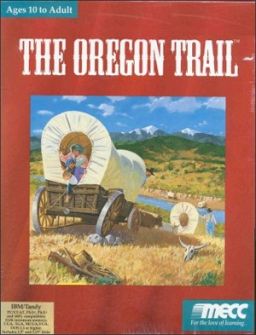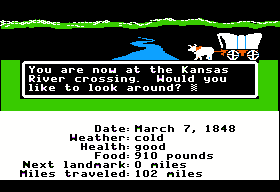The Oregon Trail (1985 video game) facts for kids
Quick facts for kids The Oregon Trail |
|
|---|---|

DOS cover art for IBM/Tandy
|
|
| Developer(s) | MECC |
| Publisher(s) | MECC (1985-1995) SoftKey Multimedia/CompuServe Incorporated (Classic Edition) |
| Designer(s) | R. Philip Bouchard |
| Platform(s) | Apple II, DOS |
| Release date(s) | 1985 (Apple II) 1990 (DOS) 1996 (Classic Edition) |
| Genre(s) | Strategy |
The Oregon Trail is a classic computer game first released in 1985. It was made by the Minnesota Educational Computing Consortium (MECC). This game teaches players about what life was like for pioneers in the 1800s. These brave people traveled the famous Oregon Trail.
In the game, you become a wagon leader. Your job is to guide a group of settlers. You travel from Independence, Missouri, all the way to Oregon's Willamette Valley. You use a covered wagon for your journey, which takes place in the year 1848.
The 1985 version of The Oregon Trail is the most famous game in the series. It was the first one to have graphics, not just text. It came out for many computers like Apple II and DOS. Over the years, many different versions of the game have been made. Together, these games have sold over 65 million copies! They are so popular that the series is even in the World Video Game Hall of Fame. This game also inspired other adventure games like The Yukon Trail and The Amazon Trail.
Contents
How to Play The Oregon Trail
In The Oregon Trail, you make many choices that affect your journey. You start by picking a job for your character. This job decides how much money you have at the beginning.
Starting Your Journey
You can choose to be one of three characters:
- A banker from Boston
- A carpenter from Ohio
- A farmer from Illinois
The banker starts with the most money. The farmer starts with the least. Before you leave, you visit a supply store. Here, you buy everything you need for your trip. This includes oxen to pull your wagon, food, clothes, and bullets for hunting.
Traveling the Trail
Your journey begins in Independence, Missouri. Along the way, you will reach many important places. These are called landmarks. At these spots, you can make decisions, buy more supplies, or rest. Some famous landmarks include:
When you get close to Oregon's Willamette Valley, you have a big choice. You can either float down the Columbia River Gorge on a raft. Or, you can take the Barlow Road. Both paths have their own challenges!
Hunting for Food
Hunting is a very important part of the game. You use guns and bullets that you bought. When you choose to hunt, you can shoot wild animals. This adds meat to your food supply.
In the first versions of the game, you aimed a rifle in eight directions. Later versions let you use a mouse or touchscreen to aim. You can shoot as many animals as you have bullets. But, you can only carry a certain amount of meat back to your wagon. In early games, it was 100 pounds. Later, it became 200 pounds if you had at least two people in your group.
Newer versions also let you hunt in different places. You might see snow-covered grass in winter. If you hunt too much, animals become "scarce." This means fewer animals appear later in the game. Some versions even let you go fishing!
Facing Challenges on the Trail
Life on the Oregon Trail was tough, and the game shows this. Members of your group can get sick. If they don't rest, they can get worse. People in your party can die from many causes. These include diseases like measles, typhoid, and dysentery. They can also die from snakebite or even accidental gunshot wounds. Your oxen, which pull your wagon, can also get hurt or die.
How You Score
At the end of your long journey, you get a score. This score shows how well you did. First, the game counts points for each person still alive in your group. It also counts your remaining supplies and any money you have left.
Then, this score is multiplied. The multiplier depends on the job you chose at the start. For example, a banker starts with a lot of money, so their score might not get a bonus. A farmer starts with less money, so their score might be tripled! This makes it harder, but more rewarding, to play as a farmer. Your final score is then added to a high-score list.


